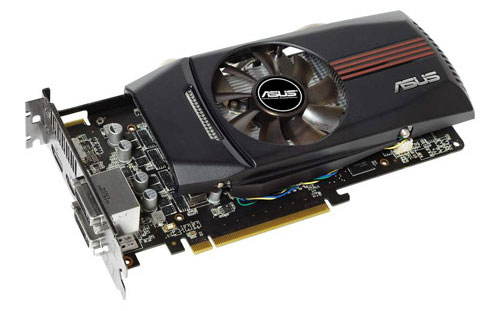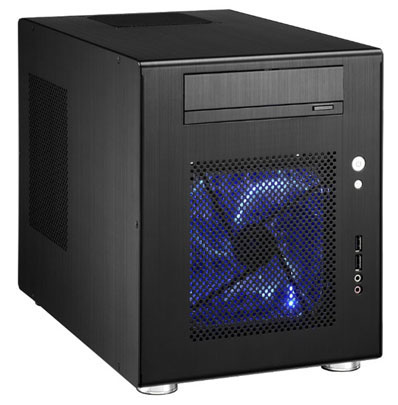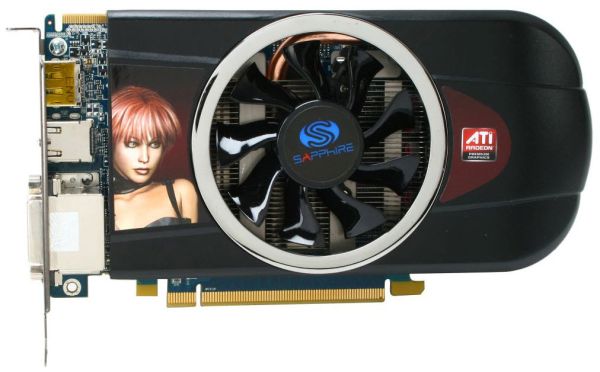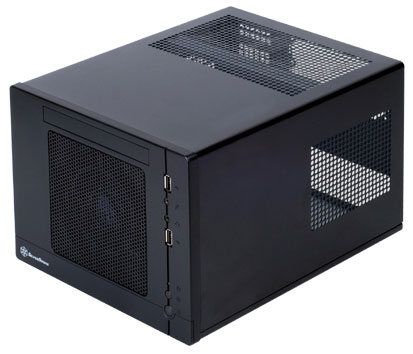Small Form Factor Buyers’ Guide
by Zach Throckmorton on May 25, 2011 10:30 AM ESTIntel Gaming SFF
Gaming rigs, with powerful CPUs and discrete GPUs, tend to produce more heat than standard desktops and HTPCs. Cramming the most power hungry components into a small space poses problems—problems that many newer SFF chassis obviate by getting a little bigger. Intel’s new Sandy Bridge CPUs are remarkably powerful while using relatively little juice. Similarly, AMD (ATI) GPUs tend to use less power under load than their NVIDIA competitors. Combine the two and it’s possible to assemble a nearly bleeding edge gaming rig in a slightly larger (13.6” x 9” x 10.8”) SFF system—and no, we aren’t going to put together a dual-GPU beast in the Silverstone FT03 chassis for this build, even if that is an option.
| Intel Gaming SFF | |||
| Component | Description | Cost | Rebate |
| Case | Lian Li PC-Q08B | $101 | |
| PSU | Antec TruePower New TP-550 | $90 | |
| CPU | Intel Core i5-2500K (4x3.3GHz, 3.7GHz Turbo, 8MB L3) | $216 | |
| Motherboard | ASUS P8H61-I | $85 | |
| GPU | ASUS EAH6850 DC/2DIS/1GD5/V2 Radeon HD 6850 | $155 | -$20 |
| Memory | Patriot 4GB (2x2GB) PSD34G1333K | $40 | |
| HDD | Samsung SpinPoint F3 HD103JS 1TB | $61 | |
| DVDRW | LITE-ON DS-8A5S | $33 | |
| OS | Windows 7 Home Premium 64-bit OEM | $100 | |
| Total Price | $881 | $861 | |
Note: The differences in case, PSU, and other components affect the total price.
If you compare with the AMD build, look at just the CPU, motherboard, and RAM.
Our Intel gaming SFF starts with the Core i5-2500K, a CPU that’s easily capable of running all the latest games (with an appropriate GPU). It uses very little power at idle and is an all around excellent chip. While it’s not quite as potent as the Core i7-2600K (thanks to the lack of Hyper-Threading), it also dissipates less

heat, making it a perfect fit for an SFF. Besides, if you’re planning on gaming and you’ll only be using a single GPU, particularly at higher resolutions there’s very little advantage to getting a faster CPU.
The AMD Radeon HD 6850 is a good match for the i5-2500K. Like the CPU, the 6850 isn’t the fastest GPU, but it’s plenty powerful and capable of playing the latest titles at 1080p and high detail settings at acceptable framerates. The 6850 is slightly slower than the previous generation 5850 (10% or less on almost all benchmarks), but it uses less power and its power connectors are better positioned (on the side vs. on the end) for use in an SFF case. It’s also about the longest video card that will fit in a mini-ITX chassis. At 10.27” in length, it fits inside the Lian Li PC-Q08B with a small amount of breathing room.
Speaking of which, I absolutely love the PC-Q09B case. It’s  somewhat large for a mini-ITX SFF chassis, but its airflow and cooling potential are very good and it can accommodate multiple 3.5” hard drives as well as a standard optical drive and PSU. For this build, we recommend a 1TB Samsung SpinPoint F3 HDD. Once you start installing games, an SSD will quickly run out of space, though you can always go the SSD + HDD combination if you choose. (We’d recommend at least a 60GB SSD, just because games periodically store additional files on the C: drive.) If you have the money, you could also get a larger 120GB SSD for the OS and apps and install a handful of favorite titles there, with any others relegated to the HDD.
somewhat large for a mini-ITX SFF chassis, but its airflow and cooling potential are very good and it can accommodate multiple 3.5” hard drives as well as a standard optical drive and PSU. For this build, we recommend a 1TB Samsung SpinPoint F3 HDD. Once you start installing games, an SSD will quickly run out of space, though you can always go the SSD + HDD combination if you choose. (We’d recommend at least a 60GB SSD, just because games periodically store additional files on the C: drive.) If you have the money, you could also get a larger 120GB SSD for the OS and apps and install a handful of favorite titles there, with any others relegated to the HDD.
Wrapping up our Intel Gaming SFF, I find modular PSUs work best in the PC-Q08B, as cable management is easier because there are fewer cables immediately adjacent to the hard drive cage. The Antec TP-550 is 80 Plus Bronze certified and has a few fixed cables with the rest being modular. If you prefer an alternative, the Seasonic M12II 520W is fully modular and 80 Plus Bronze certified. Both PSUs are very good quality and are more than sufficient wattage to power the components we selected. Just to be clear, the Antec and Seasonic PSUs (as well as other modular PSUs) are a very tight fit against the top drive cage, but with some patience, they will work.
AMD Gaming SFF
Like the HTPC segment, AMD does not currently offer any CPUs that can compete with the Intel offerings in terms of both performance and power consumption. Instead, AMD relies on cost to remain competitive. This AMD gaming system is not as powerful as the Intel system, but it costs a lot less. Here’s what we selected for this build.
| AMD Gaming SFF | |||
| Component | Description | Cost | Rebate |
| Case | Silverstone Sugo SG05-B | $105 | |
| CPU | AMD Athlon II X3 450 (3x3.2GHz, 3x512K L2) | $76 | |
| Motherboard | ASUS M4A88T-I Deluxe | $125 | |
| GPU | Sapphire 100283-3L Radeon HD 5770 | $115 | -$20 |
| Memory | Patriot 4GB (2x2GB) PSD34G1066SK SO-DIMMs | $44 | |
| HDD | Western Digital Caviar Blue WD5000AAKS | $45 | |
| DVDRW | LITE-ON DS-8A5S | $33 | |
| OS | Windows 7 Home Premium 64-bit OEM | $100 | |
| Total Price | $643 | $623 | |
| AMD Gaming Alternatives (Downgrades) | |||
| CPU | AMD Athlon II X2 250 (2x3.0GHz, 2x1MB L2) | $61 | |
| GPU | Sapphire 100287VGAL Radeon HD 5670 | $70 | -$10 |
| Total Price with Downgrade | $583 | $573 | |
Note: The differences in case, PSU, and other components affect the total price.
If you compare with the Intel build, look at just the CPU, motherboard, and RAM.
AMD’s Athlon II X3 450 offers tremendous value for the budget-conscious gamer; it uses less power than its

Black Edition Phenom II and quad-core relatives and only costs $15 more than the dual-core X2 250 we’ve recommended twice now. Matched with a Radeon HD 5770, you’ve got a very capable gaming system. At less than $100 after rebate, the Radeon HD 5770 offers astonishing value to gamers on a budget. The 5770 may not seem like much compared to other desktop GPUs, but keep in mind that this venerable GPU would rank near the top of the mobile GPU heap—it has the same number of GPU cores and is clocked higher than the Mobility HD 5870. So if you’re curious about the gaming potential, it would be roughly equal to the GTX 460M notebooks we’ve looked at recently, at less than half the price.
The Silverstone Sugo SG05-B mini-ITX chassis includes an 80 Plus certified 300W PSU. This case doesn’t have quite the airflow  potential of the Lian Li recommended above, and it’s also noisier because of the plastic construction, but it’s still a very good case. It’s also smaller at 10.9” x 8.8” x 7”. The SG05-B can house one 2.5” SSD and one 3.5” HDD, but since this is a budget build, we’re going with one 500GB Western Digital Caviar Blue mechanical HDD to keep costs down. As always, you can go with a larger capacity hard drive if necessary, and you can certainly add an SSD later if you’re interested. The case also supports a slim optical drive, so we chose a DVDRW to fill that role.
potential of the Lian Li recommended above, and it’s also noisier because of the plastic construction, but it’s still a very good case. It’s also smaller at 10.9” x 8.8” x 7”. The SG05-B can house one 2.5” SSD and one 3.5” HDD, but since this is a budget build, we’re going with one 500GB Western Digital Caviar Blue mechanical HDD to keep costs down. As always, you can go with a larger capacity hard drive if necessary, and you can certainly add an SSD later if you’re interested. The case also supports a slim optical drive, so we chose a DVDRW to fill that role.
Recommended Gaming SFF
Many popular games like StarCraft 2 and World of WarCraft have very modest hardware requirements for enjoyable gaming, especially at lower resolutions and/or detail settings. You could shave an additional $50 or so off the cost of the AMD system by using an Athlon II X2 250 CPU and Radeon HD 5670 GPU instead of the Athlon II X3 450 and Radeon HD 5770. You can see how the Athlon II X3 450 compares with Athlon II X2 255 in our CPU Bench; the 255 is about 3% faster than the 250, so you’re not missing out on much. Similarly, you can see how the 5770 compares to the 5670 in our 5670 review. The 6850 is quite a bit faster, of course, so if you can spare the extra $40 the ASUS 6850 in the Intel system will prove beneficial.
Our SFF Gaming rigs represent opposite ends of the budget spectrum, with the Intel system costing almost 50% more than the AMD system. The Intel system is certainly more capable, but if we remove all the other component differences from the table, the actual cost for the Intel SFF (CPU, motherboard, and RAM) is just under $100. If you only have a modest budget, the AMD system will suffice—you can also see how the two CPUs stack up in our CPU Bench. The AMD CPU may be inferior to the Intel CPU, but pay particular attention to the gaming performance, where the AMD triple core chip still turns out acceptable frame rates. Likewise, the Radeon HD 5770 isn’t as powerful as the Radeon HD 6850, but as you can see in GPU Bench, the cheaper GPU is still quite capable.










71 Comments
View All Comments
fujii13 - Wednesday, May 25, 2011 - link
Thanks. This is the first time I've seen the PC-Q08. Might be exactly what I'm looking for for a SFF All in one HTPC and NAS with 4+ drives. I only wish they'd nix the 5.25 drives and make it a little smaller.Forrest319 - Wednesday, May 25, 2011 - link
I built a Zacate based HTPC yesterday. Using the same antec case they used for the intl HTPC in this article. I'm happy so far.vnangia - Wednesday, May 25, 2011 - link
Hi Zach, thanks for the write up, but I've got to say, your choice in cases for the SFF HTPC leaves something to be desired. I'm not sure whether you're going for a certain budget (don't see any such considerations in your text), so perhaps consider some alternative cases, especially in place of the Lian Li.Some inexpensive suggestions:
-Thermaltake's Element Q - $80 and nicely takes the stock AMD cooler and the full-wattage Core i stock cooler as well. The smaller T/S 2011 Core i cooler leaves even more space.
-Compucase's ITX200A - a $50 case that leaves $30 to spend on a Big Shuriken or a Kozuti.
If money is no object, then there's the Luxa case and a couple of others as well. I agree there aren't nearly enough good ITX cases, but the Lian-Li seems the worst of all worlds - there's no way you're going to be putting that in a media cabinet.
ganjha - Wednesday, May 25, 2011 - link
One more case I'd like to suggest., the In-Win BK6**. I built hundreds of budget computers in those cases (BK623) and it's a decent option when you factor in it's size and that it can accommodate a µATX motherboard and includes a 300W SFX powersupply that is pretty quiet. Not a particularly reliable PSU in the long run, but does it's job.I see it's available at Newegg for $60.
Gigantopithecus - Wednesday, May 25, 2011 - link
The BK6s are nice cases - but their PSUs are in my experience unreliable, and I'm personally willing to make less money if it means I'm less likely to hear about a problem with a customer's computer!vnangia - Wednesday, May 25, 2011 - link
I think if you're going up to the mATX size cases, the Silverstone ML03B works really well - relatively compact for a mATX case, and a ITX or DTX fits in there with much less difficulty.Gigantopithecus - Wednesday, May 25, 2011 - link
Perhaps not in a traditional, horizontally-oriented media cabinet, but many of my customers do not have traditional media cabinets (if they have cabinets at all!), and the Lian Li I suggested works well for them. I should have made that clearer in the article, though, so your criticism is certainly understandable!I've used the Element Q before and found it very plasticky with an underwhelming PSU. However, I agree that it is spacious and a good budget choice. I wanted the case selections in the article for the HTPCs to be a marked contrast.
I have not used the Compucase ITX200A, and will be ordering one of those soon, as that looks an intriguing piece of hardware - thanks!
vol7ron - Wednesday, May 25, 2011 - link
Forgive me for saying, but isn't the Home Theatre portion of HTPC missing in this review?I would think that streaming/decoding digital TV via cablecard would be one of the basis of my HTPC. I'm looking at the mobos and the features and there isn't any incentive in getting the HTPC vs getting the gaming, or other alternative.
Am I wrong?
Gigantopithecus - Wednesday, May 25, 2011 - link
No. The article should have explicitly described that since most mini-ITX boards do not have a PCI nor PCIe x1 slot, you are limited to USB interface TV tuner cards if you will be using one with an HTPC. Forwarded to Jarred...As for incentive vs the gaming systems, HTPCs need less CPU power and at this point, they generally don't need discrete GPUs.
dagamer34 - Wednesday, May 25, 2011 - link
And any PCI-Express board fully in spec should be able to let you stick a PCI-Express x1 card into a PCI-Express x16 slot and have it work fine.